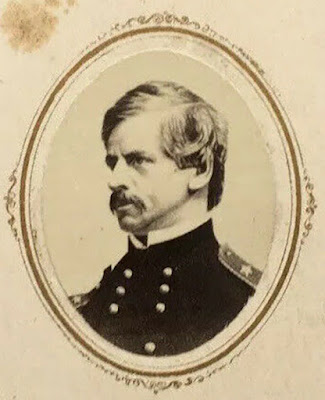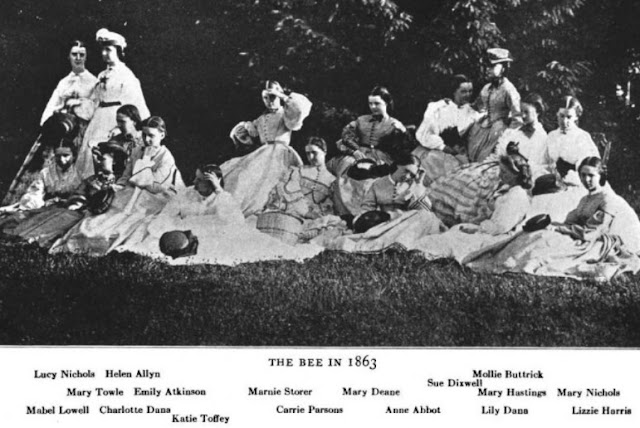A few founding members of the Banks Brigade of Cambridge,
Massachusetts, 1863
In the fall of 1861, sixteen girls from elite families of Cambridge, home to Harvard University, met at the home of Jane Loring Gray, wife of Botany Professor Asa Gray, to begin their work for Civil War soldiers.
Jane Loring Gray (1821-1909)
The Gray's home still stands
Jane Gray's niece Julia Bragg was a member.
Nathaniel Prentiss Banks (1816-1894)
This local soldiers' aid society adopted the name of Massachusetts General Nathaniel Banks. The Banks Brigade (B.B.) met until 1931.
When the war was over they shortened their name to The Bee
and continued meeting to sew for charity.
Susan Hunt Dixwell Miller (1845-1924)
Florence Sparks Moore (1845-1915)
The Brigade met every Friday afternoon throughout the war to do the usual sewing of shirts, sleepwear and quilts and knitting of "blue socks with red and white borders."
Mary Towle Palmer (1846-? ) wrote The Story of the Bee with
help from friends like Grace Hopkinson Eliot, wife of Harvard's President.
The fifteen-year-old daughters of professors recalled they lacked
experience with plain sewing.
Elizabeth Ellery Dana (1846-1939) in the 1890s
Lily mentions carrying the Bee Basket to Mrs. Waterman's. Apparently a large basket containing work to be done was left at each house in turn and last week's hostess had to carry it to the next home (probably with manly help from a servant). There was complaining. Who filled the Bee Basket wasn't noted.
Anna Page refused to sew at all, crocheting instead.
A 1918 parade celebrated the Bee's sewing for four wars.
Lilian Horsford Farlow (1848-1927)
Lilian rented a truck for the parade and furnished it with
rocking chairs for ten Bee members who knitted and saluted soldiers.
Miss Alice James (1848-1892) joined when the family moved to
Cambridge in 1867. Her brothers were William, the
philosopher, and Henry, the novelist.
Mrs. Alice Howe Gibbens James (1849-1922)
married the Harvard philosophy professor.
Bee members found her sister-in-law entertaining
& witty. Did Mrs. Alice?
Well, one could go on. The Banks Brigade and the later Bee are one of
the best documented of the local soldier's aid societies.
Do read Mary Towle Palmer's The Story of the Bee at Cambridge's history site:
And Cambridge has a Flickr page full of the members' photos, which is where many of the above portraits were obtained.




















5 comments:
How nice that Harvard has all these records! It makes it easier for you to write these interesting stories. I have never been able to knit socks, although I've tried. I admire these girls for being willing to learn.
What a great story!
Wonderful that you have found this to share with us.
Absolutely amazing information. Thank you for finding this. Thank you for sharing it ... and another thank you for sharing your talents with us.
What was the war in 1914, if it’s a different war than 1917, which I assume is WWI?
Post a Comment